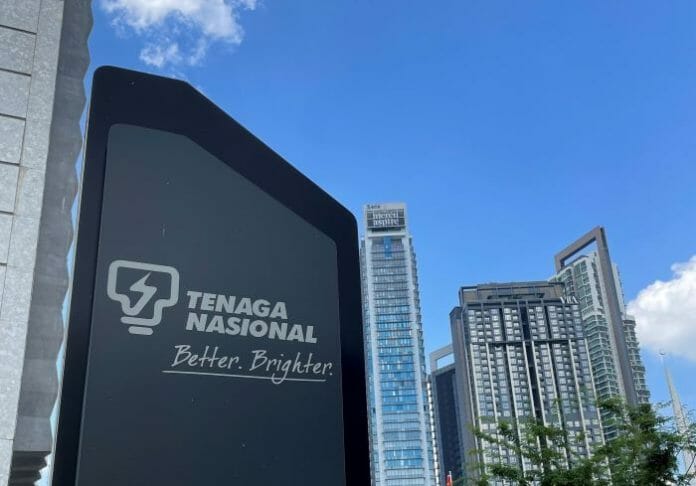Tenaga Nasional Berhad (TENAGA) is guided for electricity demand growth of 2.5%-3.0% in FY24, higher than the 1.7% embedded in Incentive-Based Regulation (IBR), underpinned largely by new data centres.
Kenanga Investment Bank Berhad (Kenanga), in its Company Update today (Mac 4), said the higher demand should entail a higher base under Regulatory Period 4, boosting TENAGA’s earnings from FY25.
Kenanga maintains their forecasts, TP of RM11.40 and MARKET PERFORM rating.
Kenanga came away from TENAGA’s post-4QFY23 results briefing feeling positive on its prospects. The key takeaways are as follows:
1. Its actual FY23 demand growth came in at 3.6%, which was higher than the 1.7% embedded in IBR, led by commercial (+7.6%) and domestic segments (+6.7%). TENAGA guided for electricity demand growth of 2.5%-3.0% in FY24, underpinned largely by new data centres.
2. In FY23, nine data centre projects with c.635MW capacity were completed which will bring annual sales of c.RM350m to TENAGA. Of these projects, two projects completed ahead of time, i.e. (i) GDS Data Centre (with total maximum demand of 85.5MW) completed three months ahead of time in Sep 2023, and, (ii) SIPP YTL Data Centre Park (with total maximum demand of 300MW) completed two months ahead of time in Oct 2023. At the same time, TENAGA has signed Electricity Supply Agreements (ESA) with nine projects for a total potential demand of 2,300MW of electricity.
3. In FY24, nine more data centre projects with c.700MW are expected to be completed while 10 new ESA are expected to be concluded with potential energy demand of 2,000MW. As such, this will result in a total potential maximum demand of >5,000MW of electricity from data centres by 2035.
4. For supply side (energy sources), TENAGA is transitioning into green entity with a c.7,700MW green energy development pipeline. This includes hydro plants, hybrid hydro-floating solar PV, hydrogen-ready combined cycle power plant, corporate green power program and large-scale solar parks. So far, the budgeted RM2.76b for FY23 energy transition (ET) capex was fully utilised while the ET capex for FY24 is RM3.33b. To recap, the Regulatory Period (RP) 3 approved ET capex is RM8.2b, to be used over FY22 to FY24.
5. For energy usage, it aims to proliferate the number of battery electric vehicles (BEV) by installing EV charge points at strategic locations across Peninsular Malaysia. In FY23, it completed five projects with 32 charge points installed. In FY24, one electron station is to be installed by 1QFY24, and five electron stations by 2QFY24. In total, these charging stations support a total of 112MW electricity demand.
6. Its rooftop solar solution subsidiary GSPARX Sdn Bhd has signed agreements with three entities, namely Universiti Malaysia Pahang, LRG Rubber Sdn Bhd and KPJ (OP; TP: RM1.95) and completed installing a total of 10MWp rooftop solar capacity, and signed agreements with Resonac Material Johor Sdn Bhd and AEON (UP; TP: RM1.00) to instal a total of 100MWp rooftop solar systems. GSPARX also collaborated with SIMEPROP (MP; TP: RM0.84) for 4.5MW solar capacity across 450 homes in the latter’s City of Elmina project. In FY24, GSPARX is expected to secure up to 160MWp additional capacity.
7. Meanwhile, the Imbalance Cost Pass-through (ICPT) under-recovery was raised by 6% to RM2.11b, first hike since 4QFY22, as fuel costs increased. However, it was still 67% off the peak of RM6.40b in 4QFY22. As a result, its receivables (including ICPT receivables) reduced substantially by 56% from the peak of RM22.0b in 4QFY22 to RM9.7b in 4QFY23.
8. For its Manjung 4 Plant which has been on unplanned outage since Dec 2023 due to steam turbine high vibration, the assessment report is likely to be out later this month or April. The annual capacity payment for this plant is c.RM700m and the company, for now, estimated the net negative earnings impact is c.RM400m. The repair works are expected to be completed this year-end.
TENAGA has already submitted the RP4 proposal to the authority early this year. To note, RP4 will start from Jan 2025.
In Kenanga’s view, should the rate of returns for regulated asset base (RAB) is to maintain at 7.3% which is the same that used in RP2 and RP3 (RP1 was 7.5%), TENAGA is still expected to post higher earnings from its regulated assets as RAB will get higher after factoring in capex.
Meanwhile, TENAGA will benefit from the higher demand growth of 3.6% in FY23A (see chart below) and projected 2.5%-3.0% growth in FY24 mentioned above as opposed to the IRB’s embedded 1.7% demand growth.
This is because any excess/shortfall from the embedded 1.7% growth, it will be adjusted through revenue adjustment mechanism, i.e., revenue cap.
However, TENAGA is able to keep the retail tariff (slightly more than 1 sen/kWh) which will have a small earnings impact to TENAGA.
On the other hand, Kenanga believes a higher demand growth assumption will be embedded in RP4 given the strong demand growth FY22A (+6.0%) and FY23A (+3.6%) and thus boost TENAGA’s earnings from FY25 onward.
Forecasts Maintained
Valuations – Kenanga also keeps their DCF-derived TP of RM11.40 (WACC: 6.7%; TG: 2%). There is no adjustment to our TP based on our ESG 3-star rating.
Investment case – Kenanga continues to like TENAGA for: (i) its dominance in power generation, transmission and distribution in Malaysia, (ii) its defensive earnings backed a resilient domestic economy and assets that are largely regulated, and (iii) its heavyweight index-linked stock status. In addition, its dividend yield is decent at 3%-4%.
However, its valuations are rich after the recent run-up in its share price. Maintain MARKET PERFORM.
Risks to Kenanga’s recommendation include: (i) ballooning under-recovery of fuel costs, straining its cash flow, (ii) a global recession hurting demand for electricity, and (iii) non-compliance of ESG standards set by various stakeholders.









